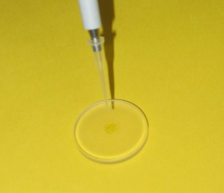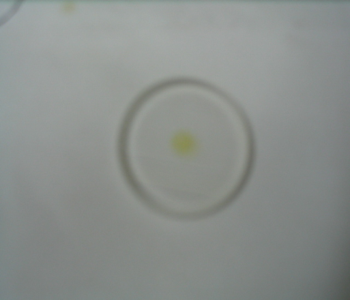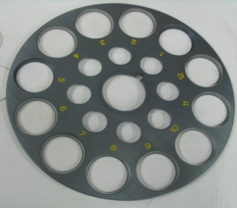
Determination of Trace Elements in Blood by Total Reflection X-ray Fluorescence(TXRF) Analysis
 People are exposed to trace elements in the environment in many ways but primarily from the foods we eat. These elements can be considered as essential, non-essential or toxic, though all can be considered as toxic in excess. It is therefore necessary to know the concentrations of trace elements we ingest. This means knowing the concentrations of these elements in our foods and in the soils on which the foods are grown since in most instances, high or low soil concentrations of these elements will result in corresponding concentrations in foods grown on these soils and by extension in humans consuming these foods. Prolonged consumption of foods at either extreme will eventually result in malnutrition, whether a deficiency or toxicity malady. The symptoms of mild to severe toxicity of trace elements are readily recognizable in humans. However, though severe trace element deficiency is well-defined and readily recognizable, milder deficiencies and imbalances often go un-noticed until they become irreversible or life threatening. Factors contributing to this phenomenon have been the absence of early warning signs of these mild deficiencies and the lack of reliable, reproducible clinical laboratory tests for the detection and quantification of trace elements in living humans especially at the low concentration levels at which they occur1. Such determinations have now been made possible with the development of new innovative analytical techniques.
People are exposed to trace elements in the environment in many ways but primarily from the foods we eat. These elements can be considered as essential, non-essential or toxic, though all can be considered as toxic in excess. It is therefore necessary to know the concentrations of trace elements we ingest. This means knowing the concentrations of these elements in our foods and in the soils on which the foods are grown since in most instances, high or low soil concentrations of these elements will result in corresponding concentrations in foods grown on these soils and by extension in humans consuming these foods. Prolonged consumption of foods at either extreme will eventually result in malnutrition, whether a deficiency or toxicity malady. The symptoms of mild to severe toxicity of trace elements are readily recognizable in humans. However, though severe trace element deficiency is well-defined and readily recognizable, milder deficiencies and imbalances often go un-noticed until they become irreversible or life threatening. Factors contributing to this phenomenon have been the absence of early warning signs of these mild deficiencies and the lack of reliable, reproducible clinical laboratory tests for the detection and quantification of trace elements in living humans especially at the low concentration levels at which they occur1. Such determinations have now been made possible with the development of new innovative analytical techniques.
The technique used in this analysis is Total Reflection X-ray Fluorescence (TXRF) spectrometry and the Schematic diagram of a TXRF spectrometer2
Sample Collection
The collection of the blood samples in this research was guided by regulations posited by the Ethics Committee at the University of the West Indies. The samples were collected from one hundred (100) healthy adults who were blood donors at the University Hospital of the West Indies. All samples were coded or anonymized and they were obtained with consent, reflecting the potential uses and any additional information.
Sample Preparation
A 200 µL aliquot of whole blood sample was added to 400 µL of concentrated, ultra-pure HNO3 and digested on a water bath for 20 minutes as were the reagent blanks of HNO3 only. The samples and blanks were made up to 2 mL with distilled de-ionized water, after which a known volume of Co internal standard was added to achieve a final concentration of 10ppm. All reagents used were analytical grade purity and distilled de-ionized water, obtained using a Barnstead E-pure system, was used exclusively. The calibration standards were prepared by serial dilutions of 10,000mg/L CertiPrep solutions in 5% HNO3.




Addition of internal standard to digested sample->Pipetting onto sample carrier ->Drying sample onto reflector -> Sample tray with reflectors.The samples were then homogenized with a vortex mixer and analyzed after pipetting 10 μL onto a quartz sample carrier/reflector and evaporating the solvent on a hot plate at low power. Blanks were treated identically to the samples. The samples were irradiated in a Wobistrax© TXRF spectrometer (Fig 2) for trace element analysis. Trace Elements in Freeze Dried Animal Blood. Haemoglobin concentrations were also determined to investigate relationships with trace element conentrations.


Figure 2. WOBISTRAX TXRF Spectrometer Calibration Spectrum viewed with WinQXAS
The accuracy and precision of the technique were assured by analyzing the Certified Reference Material (CRM) IAEA A-13 – (Trace Elements in Freeze Dried Animal Blood). This CRM was analyzed in triplicates and the mean values reported.
Shown below in Fig 4, is the comparison of measured and certified values for the SRM IAEA A-13. The recoveries generally varied between ± 20% and all are with the certified range. A summary of the elemental


The calculated concentrations for all trace elements were comparable to literature range of values3 (Table 3), except for P which was significantly lower and Zn, which indicated an elevated level for the Jamaican population. Similar levels of zinc were reported for the control group in a recent diabetic study carried out in Jamaica4. Males had higher concentrations of trace elements than females except for Rb. These results suggest that Jamaican males and female constitutes two different populations as the mean concentrations for all elements were found to be significantly different between the two. No trend was observed between age and elemental concentrations in blood.
There were correlations between Hb and elemental concentrations in both males and females but quite opposite between the two genders. As elemental concentrations increased, there was a general increase in Hb concentration in males, but a decrease was exhibited by females with the relationship with Rb being the inverse for both males and females as illustrated below.


Fig. 5 Correlation between P and Hb concentrations in Jamaican males and females Fig 6. Correlation between Rb and Hb concentrations in Jamaican males and females
Correlation between Fe and Hb was also observed which would be expected sin Fe is a constituent haemoglobin. This correlation however was only observed in males with no significant correlation between the two in females. This would suggest that a Hb count would not be sufficient to determine if a female is anaemic as she may have normal blood-Fe levels but low Hb levels.
<h4>Jamaica vs The World</h4>

picture14.pngFrom table 3 it is seen that blood elemental concentrations in Jamaicans are comparable to values from other populations around the world. The only major difference is seen in the Zn concentrations of which Jamaicans are on average 58% higher than in other countries. It is believed that this high Zn concentration may be protective against elevated Cd levels found in Some of our soils and foods.
The trace element concentrations in blood are comparable in most cases to those of other populations. Zn concentrations were however significantly elevated possibly protecting the population from soil Cd concentrations of up to 400 mg/kg. (3) Males generally had higher concentrations of trace elements and haemoglobin than females. There was no effect of age on elemental concentrations for most of the elements but Fe and Rb concentrations varied with age in both males and females.
This technique promises possible studies into the effect of trace elements on various medical disorders such as cancer, diabetes, hypertension and heart diseases among others in Jamaica and other Caribbean countries.